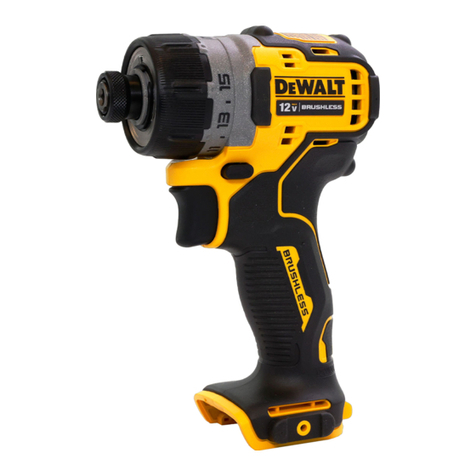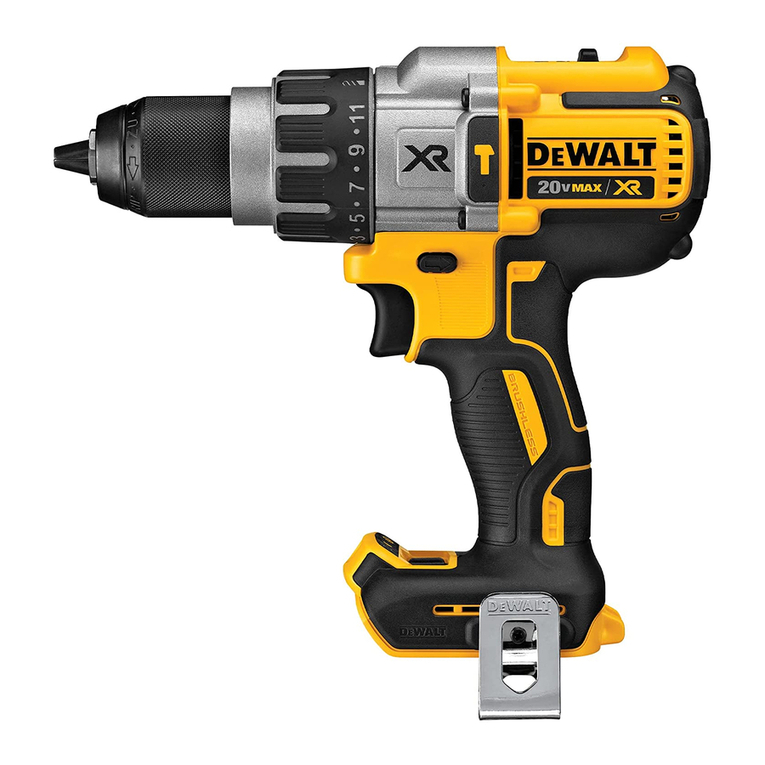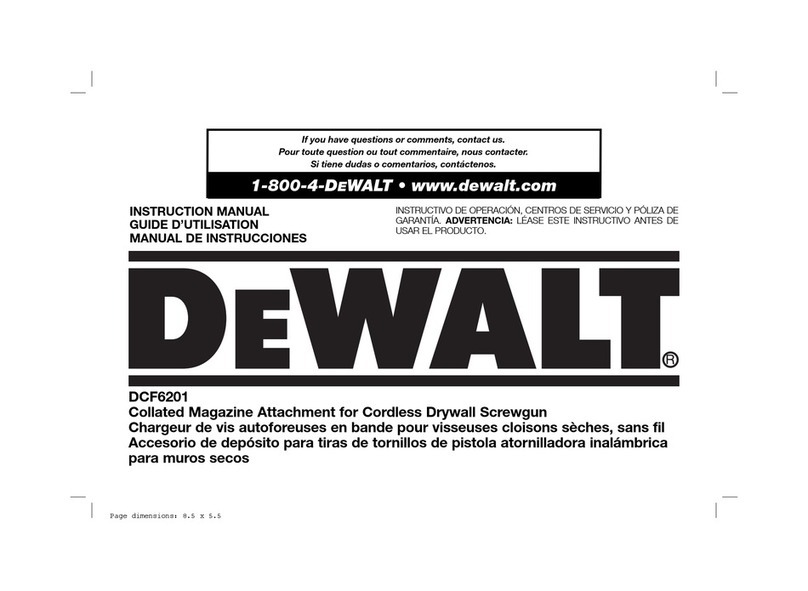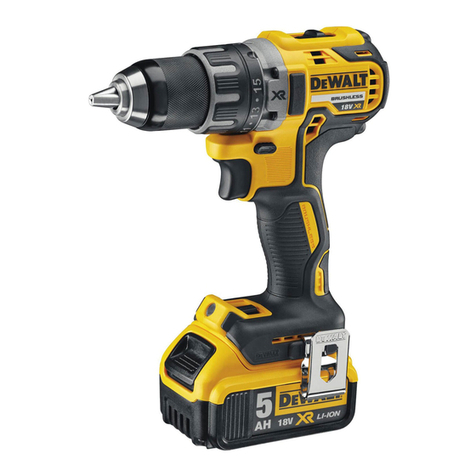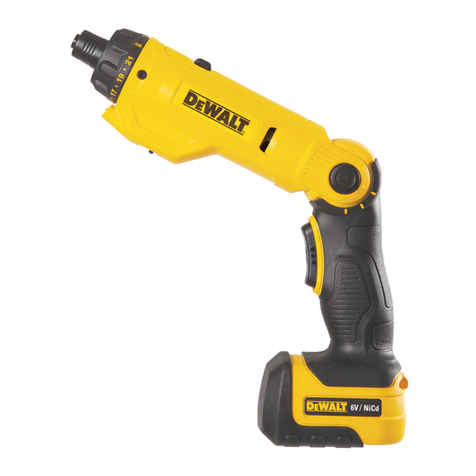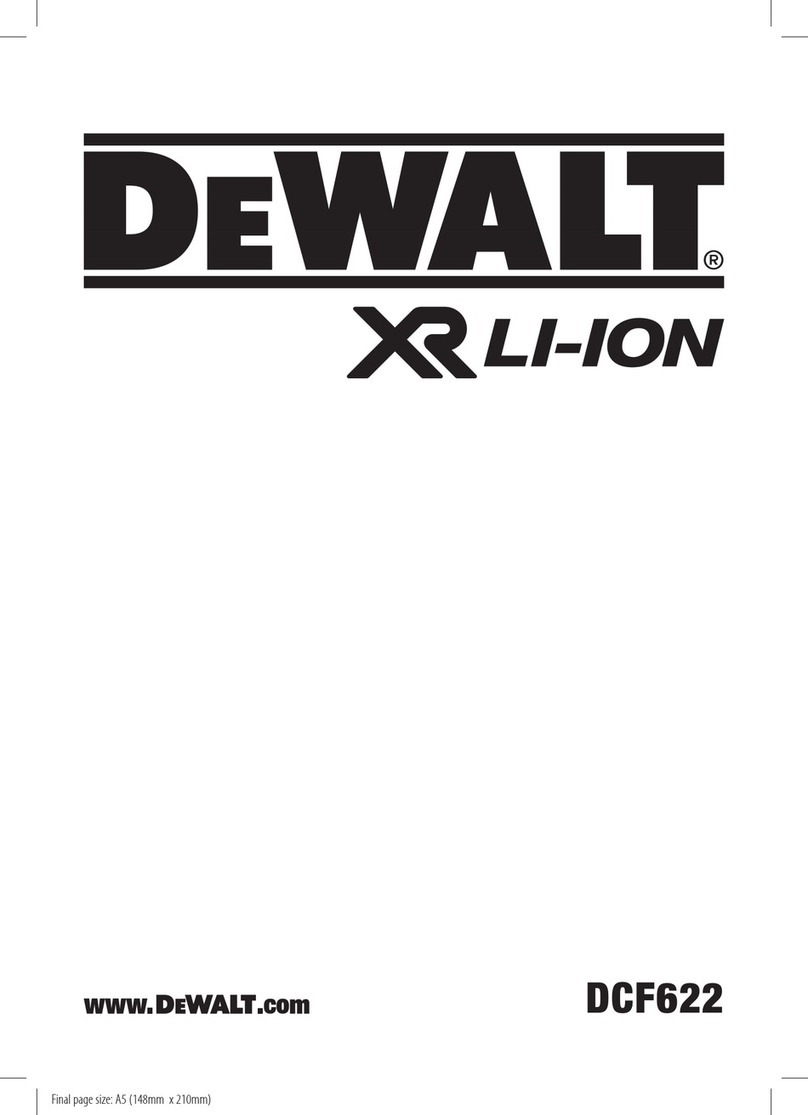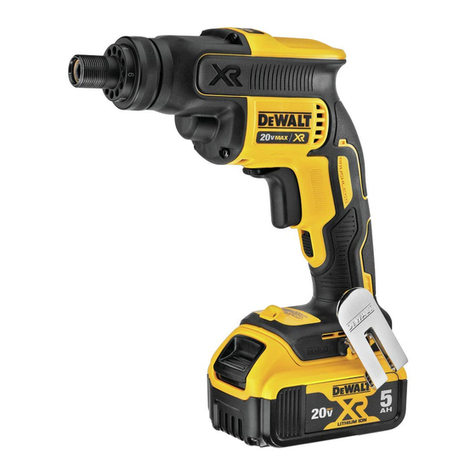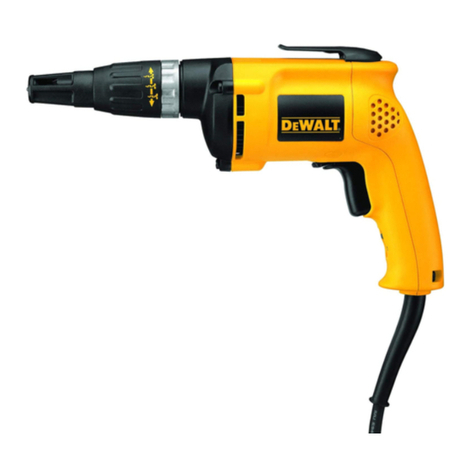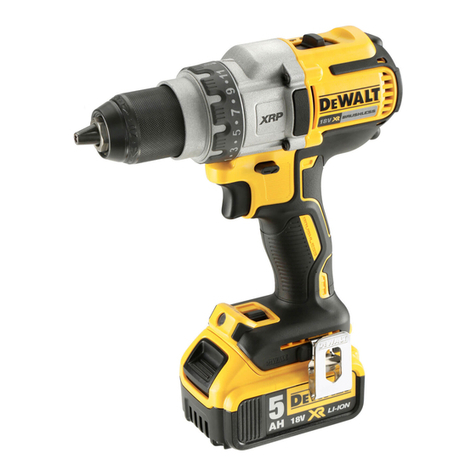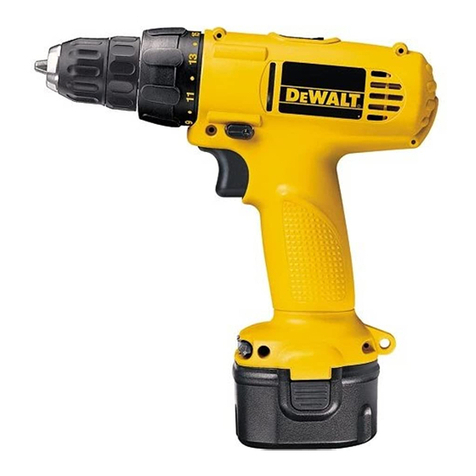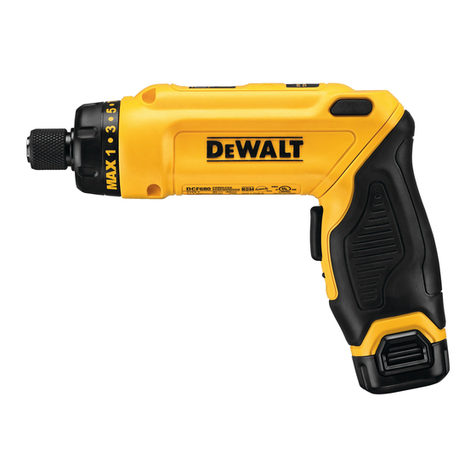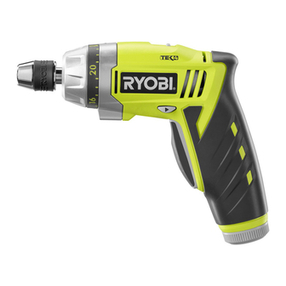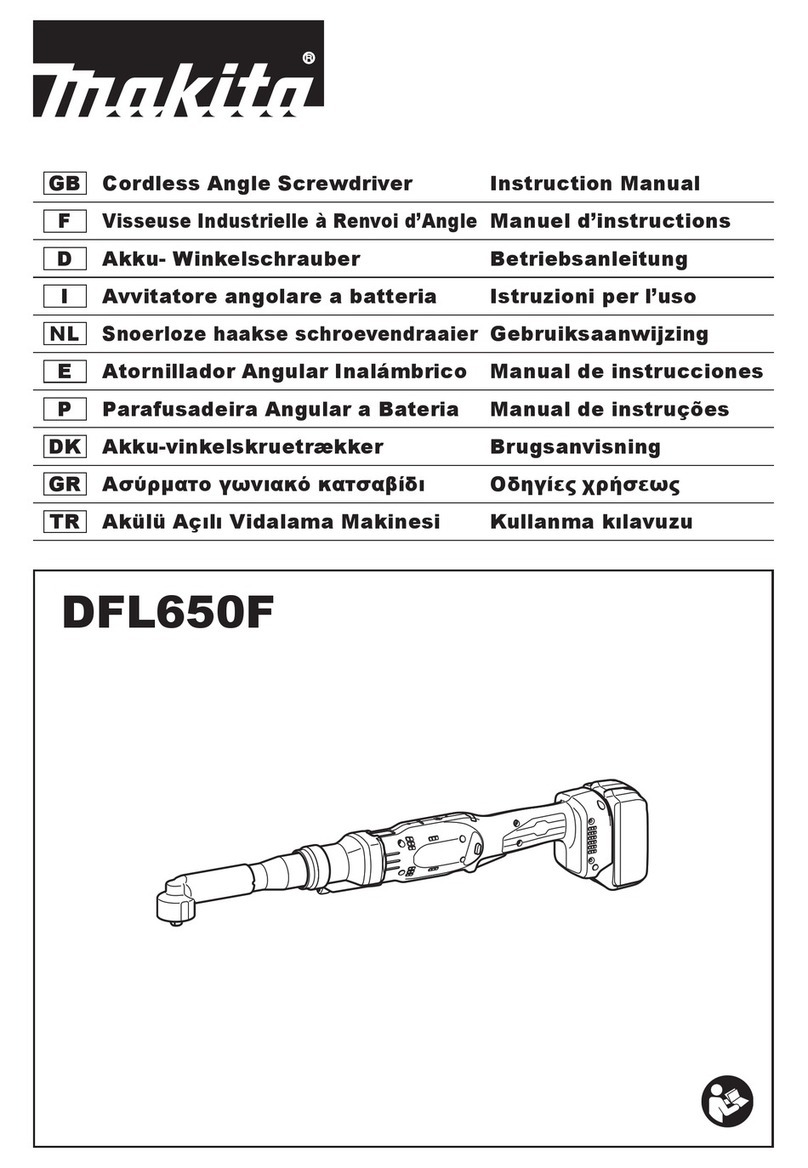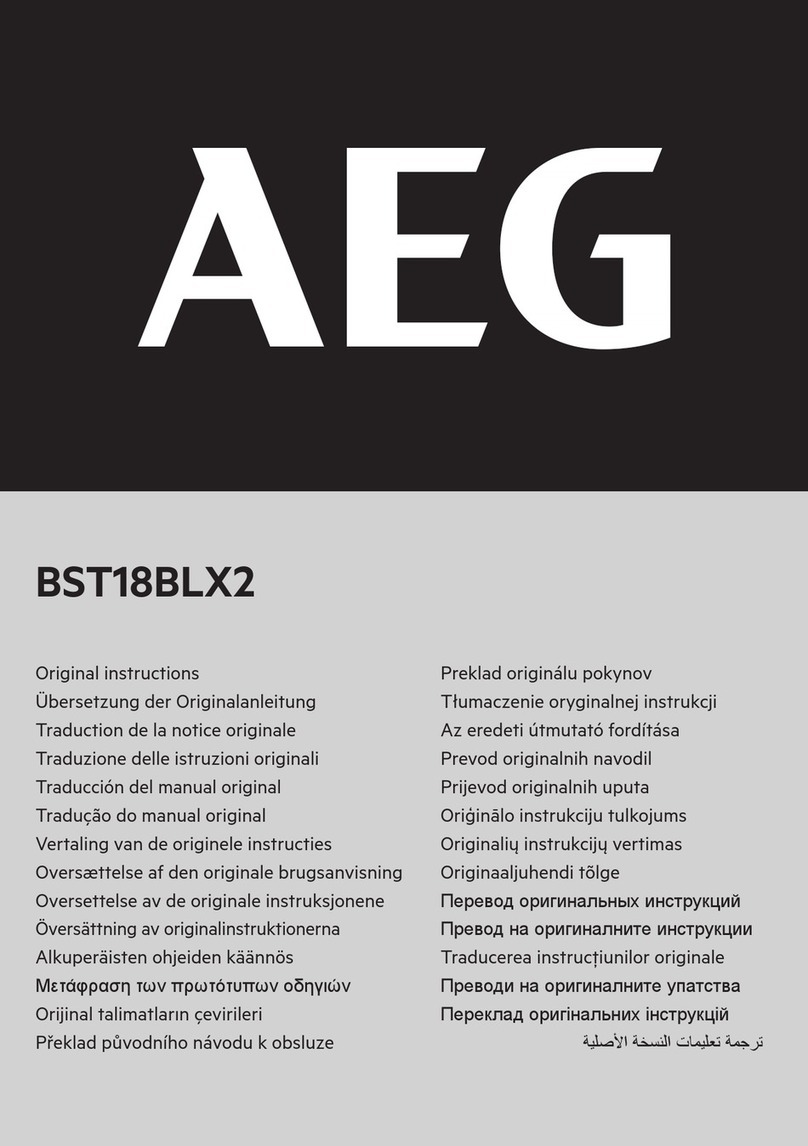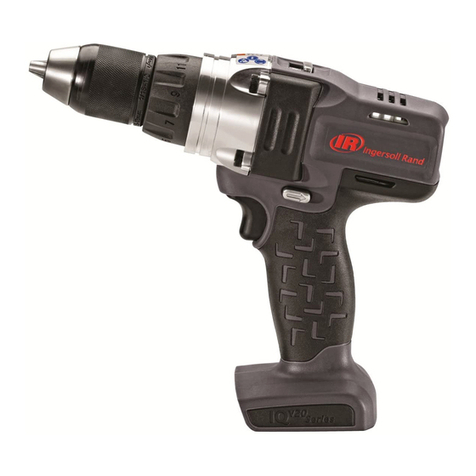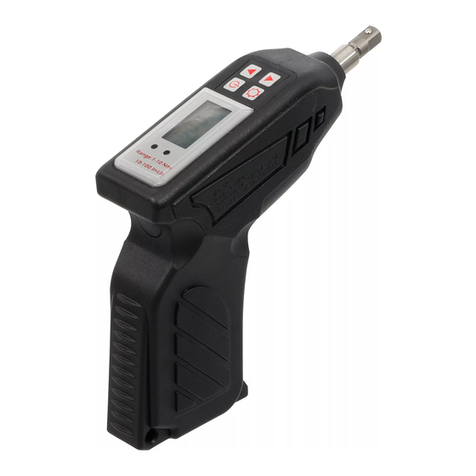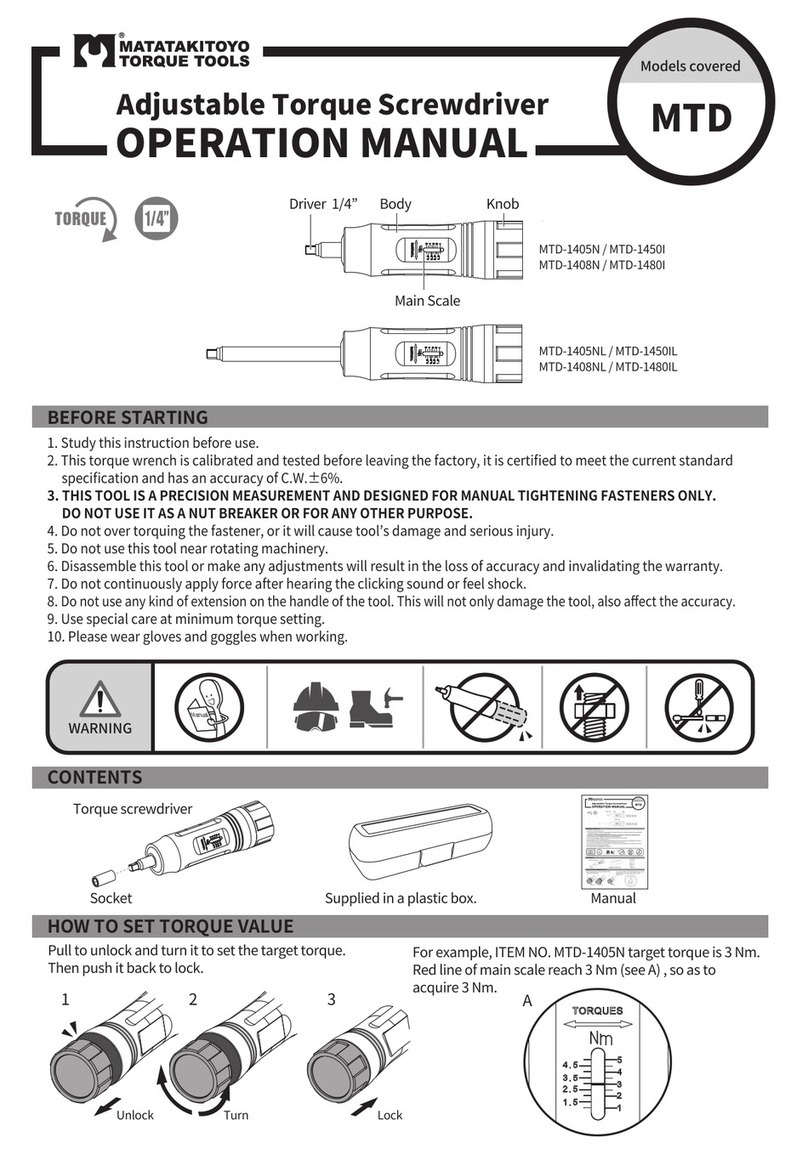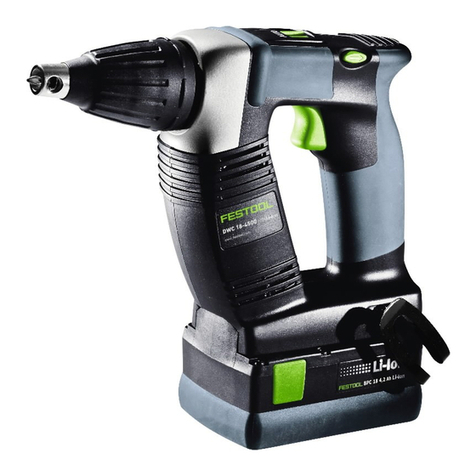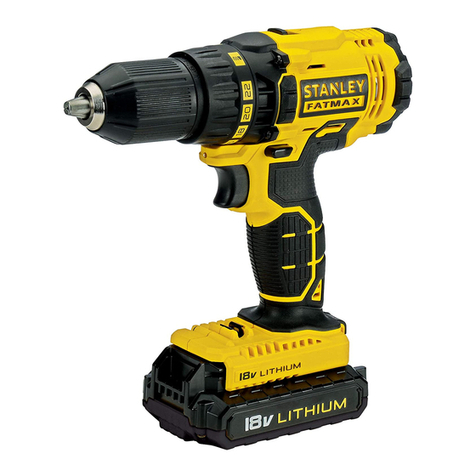E N G L I S H
4
CORDLESS SCREWDRIVER
DCF060
Technical Data
DCF060
Voltage VDC 6
Type 2
No-load speed min-1 180/600
Max. torque (Low speed) Nm 7.5
Max. torque (High speed) Nm 6.0
Tool holder
Battery capacity Ni-Cd 1.0Ah
mm 6.35 hex
Weight kg 0.8
Charger 90605144
Mains voltage VAC 220-240
Weight kg 0.16
Congratulations!
You have chosen a DEWALT tool. Years of
experience, thorough product development and
innovation make DEWALT one of the most reliable
partners for professional power tool users.
Definitions: Safety Guidelines
The definitions below describe the level of severity
for each signal word. Please read the manual and
pay attention to these symbols.
DANGER: Indicates an imminently
hazardous situation which, if not
avoided,willresult in death or serious
injury.
WARNING:Indicates a potentially
hazardous situation which, if not avoided,
couldresult in death or serious injury.
CAUTION:Indicates a potentially
hazardous situation which, if not avoided,
mayresult in minor or moderate
injury.
NOTICE: Indicates a practice not
related to personal injury which, if not
avoided, mayresult in property
damage.
Denotes risk of electric shock.
Denotes risk of fire.
WARNING:To reduce the risk of injury,
read the instruction manual.
General Power Tool Safety Warnings
WARNING! Read all safety warnings
and all instructions. Failure to follow
the warnings and instructions may result
in electric shock, fire and/or serious
injury.
SAVE ALL WARNINGS AND INSTRUCTIONS FOR
FUTURE REFERENCE
The term “power tool” in the warnings refers to your
mains-operated (corded) power tool or
battery-operated (cordless) power tool.
1) WORK AREA SAFETY
a) Keep work area clean and well lit. Cluttered
or dark areas invite accidents.
b) Do not operate power tools in explosive
atmospheres, such as in the presence
offlammable liquids, gases or dust. Power
tools create sparks which may ignite the dust
or fumes.
c) Keep children and bystanders away
whileoperating a power tool. Distractions
can cause you to lose control.
2) ELECTRICAL SAFETY
a) Power tool plugs must match the
outlet.Never modify the plug in any way.
Do not use any adapter plugs with
earthed(grounded) power tools. Unmodified
plugs and matching outlets will reduce risk of
electric shock.
b) avoid body contact with earthed or
grounded surfaces such as pipes,
radiators, ranges and refrigerators. There is
an increased risk of electric shock if yourbody
is earthed or grounded.
c) Do not expose power tools to rain or wet
conditions. Water entering a power tool will
increase the risk of electric shock.
d) Do not abuse the cord. Never use the cord
for carrying, pulling or unplugging the
power tool. Keep cord away from heat, oil,
sharp edges or moving parts. Damaged or
entangled cords increase the risk of electric
shock.
e) When operating a power tool outdoors,
use an extension cord suitable for outdoor
use. Use of a cord suitable for outdoor use
reduces the risk of electric shock.
f) If operating a power tool in a damp
location is unavoidable, use a residual
current device (RCD) protected supply.
Use of an RCD reduces the risk of electric
shock.
3) PERSONAL SAFETY
a) Stay alert, watch what you are doing and
use common sense when operating a
power tool. Do not use a power tool while
you are tired or under the influence of
drugs, alcohol or medication. A moment of
inattention while operating power tools may
result in serious personal injury.
b) Use personal protective equipment.
Always wear eye protection. Protective
equipment such as dust mask, non-skid
safety shoes, hard hat, or hearing protection
used for appropriate conditions will reduce
personal injuries.
c) Prevent unintentional starting. Ensure the
switch is in the off-position before
connecting to power source and/or
battery pack, picking up or carrying the
tool. Carrying power tools with your finger on
the switch or energising power tools that have
the switch on invites accidents.
d) Remove any adjusting key or wrench
before turning the power tool on. A wrench
or a key left attached to a rotating part of the
power tool may result in personal injury.
e) Do not overreach. Keep proper footing
and balance at all times. This enables better
control of the power tool in unexpected
situations.
f) Dress properly. Do not wear loose
clothing or jewellery. Keep your hair,
clothing and gloves away from moving
parts. Loose clothes, jewellery or long hair
can be caught in moving parts.
g) If devices are provided for the connection
of dust extraction and collection facilities,
ensure these are connected and properly
used. Use of dust collection can reduce
dust-related hazards.
4) POWER TOOL USE AND CARE
a) Do not force the power tool. Use the
correct power tool for your application.
The correct power tool will do the job better
and safer at the rate for which it was
designed.
b) Do not use the power tool if the switch
does not turn it on and off. Any power tool
that cannot be controlled with the switch is
dangerous and must be repaired.
c) Disconnect the plug from the power
source and/or the battery pack from the
power tool before making any adjust-
ments, changing accessories, or storing
power tools. Such preventive safety
measures reduce the risk of starting the power
tool accidentally.
d) Store idle power tools out of the reach of
children and do not allow persons
unfamiliar with the power tool or these
instructions to operate the power tool.
Power tools are dangerous in the hands of
untrained users.
e) Maintain power tools. Check for misalign-
ment or binding of moving parts,
breakage of parts and any other condition
that may affect the power tool’s opera-
tion. If damaged, have the power tool
repaired before use. Many accidents are
caused by poorly maintained power tools.
f) Keep cutting tools sharp and clean.
Properly maintained cutting tools with sharp
cutting edges are less likely to bind and are
easier to control.
g) Use the power tool, accessories and tool
bits etc. in accordance with these
instructions, taking into account the
working conditions and the work to be
performed. Use of the power tool for
operations different from those intended could
result in a hazardous situation.
5) SERVICE
a) Have your power tool serviced by a
qualified repair person using only identical
replacement parts. This will ensure that the
safety of the power tool is maintained.
Additional Specific Safety Rules
• Hold power tool by insulated
grippng surfaces, when perform-
ing an operation where the fasten-
er may contact hidden wiring.
Fasteners contacting a “live” wire may
make exposed metal parts of the power
tool “live” and could give the operator
an electric shock.
• Wear ear protectors with screwdrivers.
Exposure to noise can cause hearing
loss.
• The device is not intended for use by
persons (including children) with
reduced physical, sensory or mental
capabilities, or lack of experience or
knowledge, unless they are supervised or
instructed in its use by a person
responsible for their safety.
– Children must be monitored to ensure
they do not play with the appliance.
CAUTION: INDOOR USE ONLY.
The label on your tool may include the
following symbols. The symbols and their
definitions are as follows:
V................... volts
A......................amperes
Hz................. hertz
W.....................watts
min ............... minutes
~ or AC..........alternating current
or DC ........direct current
.......Class I Construction (grounded)
or AC/DC...
alternating or direct current........
.......Class II Construction (double insulated)
n0....................no load speed
…/min ..........revolutions per minute
BPM ............. beats per minute
n ......................rated speed
IPM...............impacts per minute
SPM .............strokes per minute
..................earthing terminal
sfpm........... surface feet per minute
.....................safety alert symbol
Safety Warnings and Instructions:
Charging
SAVE THESE INSTRUCTIONS:
This manual contains important safety and
operating instructions for battery chargers.
•Before using the charger, read all
instructions and cautionary markings on
the charger and product using the battery.
CAUTION: To reduce the risk of
injury, use charger only with this
product. Batteries in other
products may burst causing
personal injury or damage.
•Use only the supplied charger when
charging your tool.The use of any
other charger could damage the drill or
create a hazardous condition.
• Do not expose the charger to rain or
snow.
• Pull by the plug rather than the cord
when disconnecting the charger. This
will reduce the risk of damage to the
electric plug and cord.
• Make sure that the cord is located
so that it will not be stepped on,
tripped over or otherwise subjected to
damage or stress.
• Do not use an extension cord
unless it is absolutely necessary. Use
of improper extension cord could result in
risk of fire, electric shock or electrocution.
•When operating a charger outdoors,
always provide a dry location and use
an extension cord suitable for
outdoor use. Use of a cord suitable for
outdoor use reduces the risk of electric
shock.
•An extension cord must have
adequate wire size for safety. An
undersized cord will cause a drop in line
voltage resulting in loss of power and
overheating. When using more than one
extension to make up the total length, be
sure each individual extension
•Do not operate the charger with a
damaged cord or plug.
•Do not disassemble the charger;
take it to an authorized service center
when service or repair is required. There
are no customer serviceable parts inside.
•Disconnect the charger from the
outlet before attempting any cleaning.
This will reduce the risk of electric
shock. Removing the batteries will not
reduce this risk..
•Use only one charger when charging.
•The charger is designed to operate on
standard household electrical power.
Do not attempt to use it on any
other voltage. This does not apply to the
vehicular charger.
•DO NOT incinerate the tool or
batteries even if they are severely
damaged or completely worn out. The
batteries can explode in a fire.
•Do not incinerate the batteries. They
can explode in a fire. A small leakage of
liquid from the battery cells may occur
under extreme usage, charging or
temperature conditions. This does not
indicate a failure. However, if the outer seal
is broken and this leakage gets on your
skin:
a. Wash quickly with soap and water.
b. Neutralize with a mild acid such as
lemon juice or vinegar.
c. If the battery liquid gets in your eyes,
flush them with clean water for a
minimum of 10 minutes and seek
immediate medical attention.
MEDICAL NOTE: The liquid is a 25-35%
solution of potassium hydroxide.
Package Contents
The package contains:
1 Cordless Screwdriver
1 Charger
1 Kitbox
1 Instruction manual
• Check for damage to the tool, parts or
accessories which may have occurred during
transport.
• Take the time to thoroughly read and
understand this manual prior to operation.
Charging Procedure (Fig. 1)
WARNING:The batteries in your
tool are not fully charged at the
factory. Before attempting to
charge them, thoroughly read all of
the safety instructions.
WARNING:When disconnecting
the tool from the charger, be
sure to unplug the charger from
the outlet first then disconnect the
charger cord from the tool. Do not
use the tool while it is connected to
the charger.To charge your
screwdriver, follow the steps
below.
1. Plug the output cord of the charger into
the socket (G) in the bottom half of the
screwdriver handle as shown in Figure 1.
2. Plug the charger into an appropriate
outlet.
3. Let the tool charge initially for 9 hours.
After the initial charge, under normal
usage, your tool should be fully charged in
3 to 6 hours.
Important Charging Notes
1. After normal usage, your tool should be fully
charged in 3 to 6 hours. If the batteries are
run down completely, it may take up to 6
hours to become fully charged. Your tool
was sent from the factory in an uncharged
condition. Before attempting to use it, it
must be charged for at least 9 hours.
2.DO NOT charge the batteries in an air
teperature below 40 °F(4.5 °C), or above
105 °F (40.5°C). This is important and will
prevent serious damage to the batteries.
Longest life and best performance can be
obtained if the batteries are charged when
the air temperature is 75 °F (24 °C).
3. The charger may hum and become warm
to the touch while charging. This is a
normal condition, and does not indicate a
problem.
4. If the battery pack does not charge
properly:
a. Check operation of receptacle by
plugging in a lamp or other appliance;
b. Check to see if receptacle is connected
to a light switch which turns power off
when you turn out the lights;
c. Move the charger and tool to a location
where the surrounding air temperature is
approximately 40 °F – 105 °F (4.5° – 4.5
°C)
d. If charging problems persist, take the
tool and charger to your local service
center.
5. The tool should be recharged when it fails
to produce sufficient power on jobs which
were easily done previously. DO NOT
CONTINUE using product with its batteries
in a depleted condition.
6. To prolong battery life, avoid leaving on
charge for extended periods of time (over
30 days without use). Although overcharg-
ing is not a safety concern, it can signifi-
cantly reduce overall battery life.
7. The batteries will reach optimum perfor-
mance after being cycled 5 times during
normal usage. There is no need to run the
batteries down completely before recharg-
ing. Normal usage is the best method of
discharging and recharging the batteries.
Safety Warnings and Instructions:
Drilling
WARNING: Tool may stall (if
overloaded or improperly used)
causing a twist. Always expect the
stall. Grip the drill firmly to control
the twisting action and prevent
loss of control which could cause
personal injury. If a stall does
occur, release the trigger immedi-
ately and determine the reason for
the stall before restarting.
•Hold tool firmly to control its twisting
action.
Description (FIG. 2)
WARNING: Never modify the
power tool or any part of it.
Damage or personal injury could
result.
A. Quick release collar
B. Torque control collar
C. LED Light
D. Two speed switch
E. Forward / reverse switch
F. Release button
G. Charging port
OPERATION
WARNING: Always observe the
safety instructions and applicable
regulations.
Inserting an Accessory (Fig. 2, 3)
1. Hold the screwdriver upright as shown in
Figure 3 and pull down on the quick
release collar (A).
2. Insert a hex shank accessory into the
holder.
3. Release the quick release collar.
NOTE: If bit does not fit into spindle,
rotate the bit and reinsert it.
Removing an Accessory (Fig. 2, 3)
1. Hold the screwdriver upright as shown in
Figure 3 and pull down on the quick
release collar (A).
2. Pull accessory straight out.
Switch (Fig. 2)
To turn the tool ON in a forward direction,
press the top section of the rocker switch (E)
and the tool will run. Release pressure from
the switch and the tool will stop.
To operate in reverse, press the bottom
section of the rocker switch. Without
depressing the rocker switch the tool is
locked and will act as any conventional,
non-powered screwdriver.
Angling the Screwdriver (Fig. 2, 4)
WARNING:
• To avoid being pinched, holdthe
screwdriver as shown in Figure 4 when
changing positions.
• Do not use screwdriver as a pry bar in
any position.
• To avoid screwdriver being turned on
accidentally, do not carry in your pocket.
To convert the tool to an angled screwdriver,
push in on the release button(F) shown in
Figure 4 and rotate the top portion of the tool
until it locks into one of the remaining two
positions.
Torque Control (Fig. 2, 5)
The torque adjustment collar (B) ismarked
with numbers and a drill bit icon. There are
22 clutch settings in all. Each click in a
clockwise direction means an increase in
the torque produced.
To set the torque align the desired setting
with the arrow on the tool housing. The
higher the number on the collar, the higher
the torque.
To lock the clutch for heavy fastening opera-
tions, move to the drill bit icon.
If you do not know the appropriate setting to
use when tightening a screw, begin at the
lowest torque setting. If the clutch ratchets
before the desired result is achieved, increase
the collar setting and continue tightening the
screw. Repeat until you reach the correct
setting. button (F) shown in Flgure 4 and
rotate the top portion of the tool until
Two Speed Operation (Fig. 2)
The dual range feature of your screwdriver
allows you to shift gears for greater versatility.
To select low speed, (high torque setting),
turn tool off and permit to stop. Push the
slide switch (D) located on the top of the tool
to the left. Use low speed for screwdriving
operations. To select the high speed, (low
torque setting), turn tool off and permit to
stop. Slide gear shifter fully to the right. Use
high speed for drilling operations.
LED Light (Fig. 2)
To turn the light (C) on, push the slide switch
located on the underside of the screwdriver
toward the front of the tool.
Drilling
WARNING: It is important to
support work properly and to hold
the drill firmly to prevent loss of
control which could cause personal
injury If you have questions on how
to operate tool, contact an
authorized service center or other
qualified service personnel.
• Use sharp drill bits only.
• Support and secure work properly, as
instructed in the safety Instructions.
• Use appropriate and required safety
equipment, as instructed in the safety
instructions.
• Secure and maintain work area, as
instructed in the safety instructions.
• Run the drill very slowly, using light
pressure, until the hole is started enough
to keep the drill bit from slipping out of it.
• Apply pressure in a straight line with the
bit. Use enough pressure to keep the bit
biting but not so much as to stall the
motor or deflect the bit.
• Hold the tool firmly with two hands to
control its twisting action.
• DO NOT CLICK THE TRIGGER OF A
STALLED DRILL OFF AND ON IN AN
ATTEMPT TO START IT. DAMAGE TO
THE DRILL CAN RESULT.
•Minimize stalling on breakthrough by
reducing pressure and slowly drilling
through last part of hole.
•Keep the motor running while pulling
the bit out of a drilled hole This will help
reduce jamming.
•Make sure switch turns drill on and
off.
Drilling In Wood
Holes in wood can be made with the same
twist drill bits used for metal. These bits
should be sharp and should be pulled out
frequently when drilling to clear chips from
the flutes.
NOTE: This tool is not recommended for
drilling in metal or masonry.
MAINTENANCE
Your DWALT power tool has been designed to
operate over a long period of time with a minimum
of maintenance. Continuous satisfactory operation
depends upon proper tool care and regular
cleaning.
WARNING: To reduce the risk of
serious personal injury, turn tool off
before making any adjustments or
removing/installing attachments or
accessories. An accidental start-up can
cause injury.
This machine is not user-serviceable. Take the tool
to an authorised repair agent after approximately
40 hours of use. If problems occur before this time
contact an authorised repair agent.
The charger and battery pack are not serviceable.
There are no serviceable parts inside.
Lubrication
Your power tool requires no additional lubrication.
Cleaning
WARNING: Blow dirt and dust out of
the main housing with dry air as often as
dirt is seen collecting in and around the
air vents. Wear approved eye protection
and approved dust mask when
performing this procedure.
WARNING: Never use solvents or other
harsh chemicals for cleaning the
non-metallic parts of the tool. These
chemicals may weaken the materials
used in these parts. Use a cloth
dampened only with water and mild
soap. Never let any liquid get inside the
tool; never immerse any part of the tool
into a liquid.
CHARGER CLEANING INSTRUCTIONS
WARNING:Shock hazard. Disconnect
the charger from the AC outlet before
cleaning. Dirt and grease may be
removed from the exterior of the charger
using a cloth or soft non-metallic brush.
Do not use water or any cleaning
solutions.
Optional Accessories
WARNING:Since accessories, other
than those offered by DEWALT, have not
been tested with this product, use of
such accessories with this tool could be
hazardous. To reduce the risk of injury,
only DEWALT recommended accessories
should be used with this product.
Various types of SDS Plus®drill bits and chisels are
available as an option.
Accessories and attachments used must be
regularly lubricated around the SDS Plus®fitment.
Consult your dealer for further information on the
appropriate accessories.
Protecting the Environment
Separate collection. This product must
not be disposed of with normal
household waste.
Should you find one day that your DEWALT product
needs replacement, or if it is of no further use to
you, do not dispose of it with household waste.
Make this product available for separate collection.
Separate collection of used products
and packaging allows materials to be
recycled and used again. Re-use of
recycled materials helps prevent
environmental pollution and reduces
the demand for raw materials.
Local regulations may provide for separate
collection of electrical products from the household,
at municipal waste sites or by the retailer when you
purchase a new product.
DEWALT provides a facility for the collection and
recycling of DEWALT products once they have
reached the end of their working life. To take
advantage of this service please return your
product to any authorised repair agent who will
collect them on our behalf.
You can check the location of your nearest
authorised repair agent by contacting your local
DEWALT office at the address indicated in this
manual. Alternatively, a list of authorised DEWALT
repair agents and full details of our after-sales
service and contacts are available on the Internet
at: www.2helpU.com.
Rechargeable Battery Pack
This long life battery pack must be recharged when
it fails to produce sufficient power on jobs which
were easily done before. At the end of its technical
life, discard it with due care for our environment:
• Run the battery pack down completely, then
remove it from the tool.
• Ni-Cd cells are recyclable. Take them to your
dealer or a local recycling station. The collected
battery packs will be recycled or disposed of
properly.

